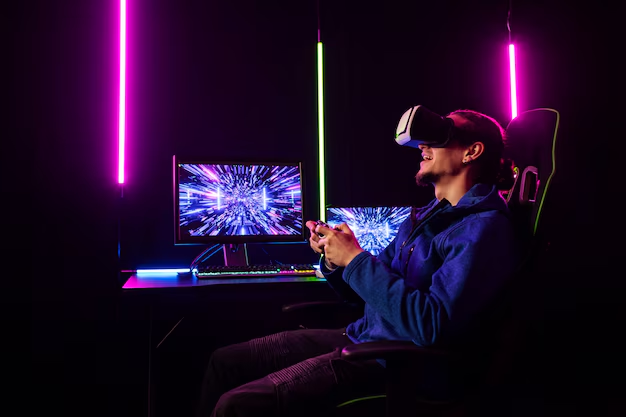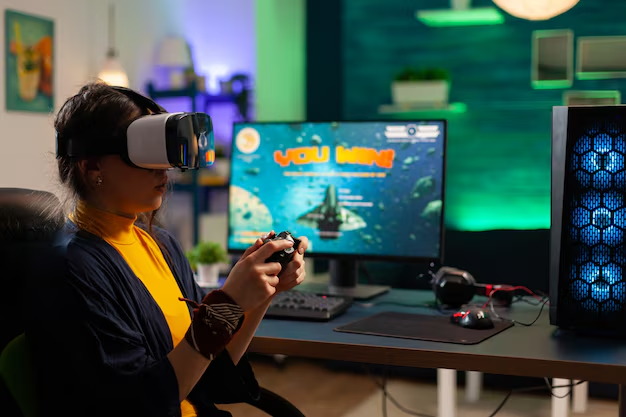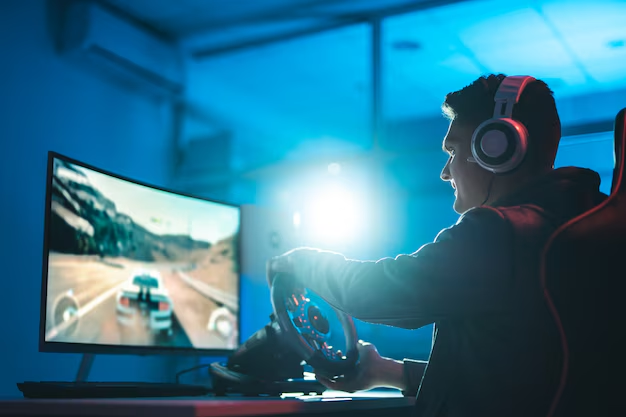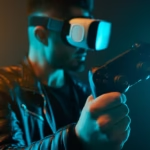Next Level Graphics The Future of Game Visuals Explained ,The development of computer game designs has been a foundation of the gaming business’ advancement, driving vivid encounters and reclassifying the limits of narrating. From the pixelated appeal of early arcade games to the amazing photorealism of the present AAA titles, the mission for visual flawlessness proceeds unabated. As innovation progresses, game designers are utilizing state of the art apparatuses and strategies to make illustrations that rival reality. The fate of game visuals is a mix of creative development and innovative leap forwards, encouraging to change how players see and draw in with virtual universes.
Real-Time Ray Tracing
Quite possibly of the main progression molding the fate of game designs is ongoing beam following, an innovation that reenacts the way of behaving of light with unrivaled precision. By following beams of light as they collaborate with items and surfaces in a game climate, designers can accomplish reasonable reflections, shadows, and lighting impacts. Already, these impacts were approximated utilizing complex stunts and pre-delivered resources, which restricted their dynamism. Beam following, controlled by current GPUs like NVIDIA’s RTX series, empowers continuous calculation of light connections, carrying another degree of realness to game visuals. As this innovation turns out to be more open, players can expect games that vibe really exact, with conditions that answer progressively to alters in lighting and viewpoint.
AI-Driven Upscaling
Another key advancement is the utilization of man-made intelligence driven upscaling methods, like NVIDIA’s DLSS (Profound Learning Super Testing). This innovation permits games to deliver at lower goals while utilizing computer based intelligence to upscale the picture to higher goals with momentous lucidity.

The outcome is outwardly shocking games that run proficiently even on mid-range equipment. By upgrading execution without forfeiting quality, simulated intelligence driven upscaling is making high-devotion illustrations more open to a more extensive crowd. This democratization of cutting edge visuals guarantees that players can appreciate vivid encounters no matter what their gadget determinations.
Photogrammetry Advancements
Photogrammetry, an interaction that includes catching genuine items and conditions to make super nitty gritty 3D models, is another distinct advantage. By checking actual items and changing over them into advanced resources, engineers can accomplish a phenomenal degree of authenticity in surfaces and plans. Games like The Remainder of Us Part II and Microsoft Pilot training program have previously exhibited the capability of photogrammetry, conveying conditions that obscure the line between the virtual and the genuine. As instruments and methods improve, photogrammetry is set to turn into a standard practice in the business, permitting designers to make universes that are however valid as they seem to be locking in.
VR and AR Graphics
The reconciliation of computer generated reality (VR) and expanded reality (AR) into gaming is pushing graphical devotion higher than ever. VR depends intensely on practical visuals to make a feeling of inundation, requiring high-goal surfaces, exact lighting, and consistent casing rates. Likewise, AR overlays computerized components onto certifiable conditions, requesting exact delivering and arrangement. Progresses in equipment, like VR headsets with higher goals and more extensive fields of view, are empowering designers to drive graphical limits further. Combined with the handling force of present day GPUs, VR and AR are preparing for hyper-reasonable gaming encounters.
Procedural Generation
Procedural age is one more encouraging outskirts in game illustrations. This procedure utilizes calculations to establish immense and point by point conditions progressively, diminishing the requirement for manual resource creation. Via mechanizing the age of scenes, surfaces, and items, procedural age permits engineers to zero in on imagination while guaranteeing that no two conditions are something similar. Games like No Man’s Sky and Minecraft exhibit the capability of this methodology, offering limitless investigation potential open doors without settling for less on visual quality. As calculations become more modern, procedural age will assume a key part in creating outwardly dazzling and different game universes.
Next-Gen Consoles’ Power
The change to cutting edge control center and gaming laptops has additionally sped up the advancement of game visuals. Consoles like the PlayStation 5 and Xbox Series X are furnished with equipment planned explicitly for high-constancy designs, including custom GPUs, SSDs for quicker stacking times, and backing for beam following. These headways permit designers to make games with more prominent visual intricacy, including denser conditions, more definite person models, and exact movements. The force of these stages is opening additional opportunities for narrating and inundation, setting a high bar for future titles.
Cloud Gaming Accessibility
Cloud gaming is another pattern affecting the fate of game visuals. By offloading handling assignments to strong distant servers, cloud gaming stages like Google Stadia, NVIDIA GeForce Now, and Xbox Cloud Gaming empower players to appreciate very good quality illustrations on gadgets with insignificant equipment abilities. This approach eliminates hindrances to section for outwardly requesting games, making them open to a worldwide crowd. As web framework improves and 5G organizations extend, cloud gaming will assume a vital part in conveying powerful illustrations to players all over the place.
Artistic Innovations
Notwithstanding innovative progressions, the creativity behind game visuals is developing. Engineers are trying different things with special workmanship styles and visual narrating procedures to make important encounters. Games like Cuphead, with its hand-drawn 1930s animation stylish, and Excursion, with its moderate yet suggestive plan, show that development in visuals isn’t restricted to authenticity. By mixing innovation with innovativeness, engineers are creating games that are however outwardly striking as they may be sincerely thunderous.
Advanced Motion Capture
One more basic part representing things to come of game visuals is the job of activity and movement catch innovation. Current games depend on modern movement catch frameworks to record the developments and articulations of entertainers, making an interpretation of them into similar livelinesss for characters. Progresses in facial acknowledgment and body following are empowering more nuanced and expressive exhibitions, upgrading the close to home profundity of games. With instruments like Unbelievable Motor’s Meta Human Maker, designers can make hyper-sensible human characters that push the limits of acceptability.
AI in Visual Creation
The ascent of man-made intelligence in game improvement is additionally changing the way that visuals are made and streamlined. Game graphics future Simulated intelligence controlled apparatuses can create surfaces, plan resources, and, surprisingly, invigorate characters with insignificant contribution from engineers. These instruments smooth out work processes and permit groups to zero in on refining the imaginative vision of their games. In addition, artificial intelligence can break down player conduct to progressively change designs settings, guaranteeing ideal execution without compromising visual quality. This versatile methodology guarantees that games run as expected on a great many gadgets while conveying shocking visuals.
Sustainability in Graphics
As the business advances, supportability is turning into a fundamental thought in game turn of events. High-devotion designs frequently require critical computational assets, prompting expanded energy utilization. Designers are investigating ways of advancing delivering methods and equipment to diminish the natural effect of making and messing around. By offsetting visual greatness with supportability, the business can keep on advancing mindfully.

Challenges in Game Visuals
In spite of the unimaginable headways in game visuals, challenges remain. Making photorealistic illustrations calls for significant investment, exertion, and assets, making great games more costly to create. Also, as player assumptions keep on rising, designers face strain to convey outwardly staggering encounters without compromising interactivity or narrating. Finding some kind of harmony is critical to guaranteeing that games stay connecting with and available.
Future Possibilities
Planning ahead, the opportunities for game visuals are basically boundless. Advancements like quantum registering and holographic presentations could reclassify what is feasible in gaming, offering encounters that are undefined from the real world. In the interim, the reconciliation of computer based intelligence, VR, and AR will keep on pushing the limits of submersion and intuitiveness. As these innovations join, the line between the advanced and actual universes will obscure, making gaming encounters that are more similar, drawing in, and genuinely effective than any time in recent memory.
Conclusion
All in all, the fate of game visuals is an outright exhilarating combination of mechanical development and imaginative imagination. From ongoing beam following and simulated intelligence driven upscaling to photogrammetry and procedural age, the instruments and strategies accessible to engineers are changing what games look like and feel. These progressions are improving authenticity as well as empowering more different and comprehensive visual encounters. As innovation advances and additional opportunities arise, the gaming business will keep on pushing the limits of what is outwardly attainable, conveying encounters that enthrall players and reclassify narrating. The excursion to powerful designs is not even close to finished, and the best is on the way.


